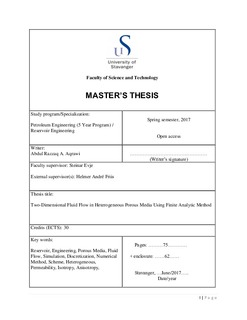| dc.description.abstract | This study started by exploring the different discretization methods that have been explored and developed throughout the years for reservoir simulators. Understanding simulators in general and how they are used in the oil and gas industry was essential to fully grasp the extent that this topic has been investigated. An interesting and new development in this field comes from a couple of individuals from a research group at the University of China in the department of Thermal Science and Energy Engineering. They utilized analytical techniques as a bases for solving for heterogeneous reservoirs. The most common method used in the industry today is the harmonic mean method for discretizing/representing the permeability at the grid interfaces. This has been proven to highly under estimate the effective permeability of heterogeneous reservoirs. Especially as the permeability ratio between the grid cells increase. The results would have a low resolution, and where there is low resolution in the effective permeability calculation, there are inaccuracies in the pressure field. And so, these researchers developed a method, the finite analytic method, and it proved to be highly accurate on both synthetic checkerboard data, and real data. Even more surprising, very little grid refinement was needed to achieve results with minimal error margins (Liu & Wang, 2013). Thus, an extension to this method was decided to be the main focus of this study. More specifically, enhancing the method to be able to solve for anisotropic permeabilities.
Starting by first implementing the method described by the article. This proved to be a very challenging task as insufficient information was supplied by the article. However, what most puzzling was the fact the pressure equations presented proved to be incorrect and the results erroneous. Therefore, a great amount of time was dedicated to first understanding the method on a fundamental and mathematical level, and then actually correctly derive and express the pressure equations. After the corrections were done, the results become directly comparable with that which was presented in the article. This was compared to other industry standard methods, mainly geometric mean and harmonic mean, and the finite analytic method proved to be much more reliable and much more accurate. The test were done on a mirrored checkerboard, and it was tested with varying grid refinements (4x4, 16x16, 64x64) and varying permeability ratios (1:2, 1:10, 1:100, 1:1000, 1:10000). The permeability tested here was isotropic.
Lastly, a novel technique was developed for solving anisotropic permeabilities. Basing the method on the core concepts of the finite analytic method for isotropic permeability discussed in the article, an anisotropic extension was derived and implemented. However, due to the time required to correct for the pressure equations earlier, little time was left to fully implement the anisotropic approach. As such, there was not enough time to adapt the necessary calculations that are needed to solve for the boundaries for anisotropic permeabilities. Therefore, this method could only be tested on isotropic data. Nevertheless, the method gave identical results to that of the isotropic approach, validating the methodology applied to it. Therefore, the first component that should be implemented in the future should be the MPFA method to solve for anisotropic permeabilities at the boundary (Aavatsmark, Reiso, Reme, & Teiland, 2001). Other than that, so that the method is comparable with current industry standard software, multi phase flow and three dimensional solutions should be derived as well. Unstructured grids could be explored once these other, more vital, parts are applied. | nb_NO |
